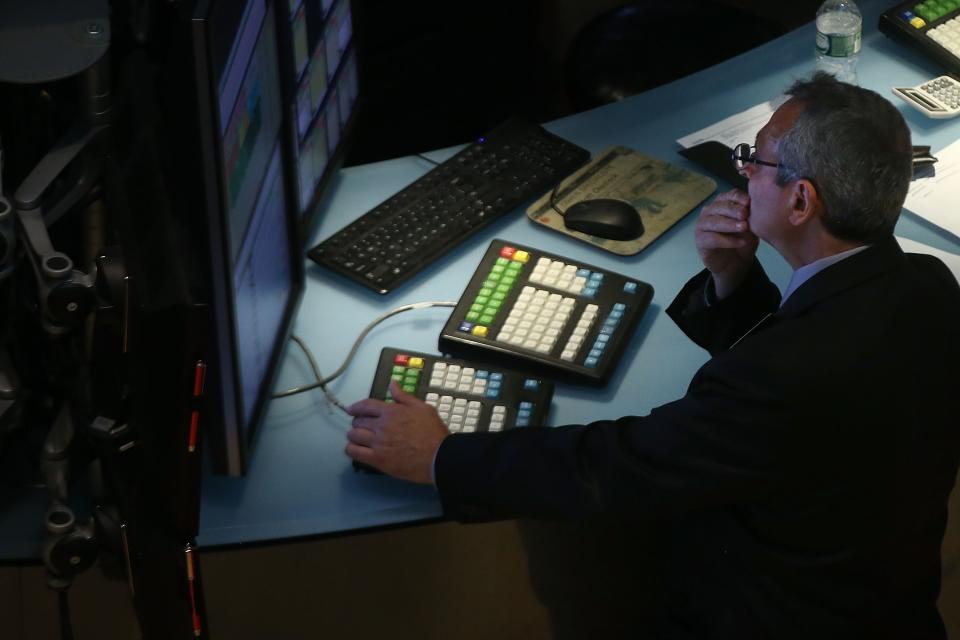The stock market is irrational right now — here’s how you can tell
By many measures the stock market is acting wildly irrational right now, perhaps opening the door to a long-awaited attractive buying opportunity.
Anywhere investors look at the moment there is carnage. October has seen the bull market derailed at the hands of global growth slowdown fears, peak profit margin worries, a perception of an unfriendly Federal Reserve (says relentless critic, President Donald Trump), and the unknown that is the U.S. mid-term elections.
The Dow Jones Industrial Average has lost 6.7% in October, the small-cap Russell 2000 has plunged 13% and the S&P 500 has tanked 9%.
Once high-flying tech stocks such as Amazon (AMZN) and proxies on the global economy like airlines have been battered month-to-date on the Dow.
Month-to-date performance
Bank of America (BAC): -10.5%
Citigroup (C): -10.5%
American Airlines (AAL): -21%
Southwest Airlines (LUV): -21%
Nvidia (NVDA): -30%
Advanced Micro Devices (AMD): -42%
IBM (IBM): -17%
The sell-off has brought stock valuations down to levels below where they were in President Barack Obama’s final year in office (back then, the U.S. saw sub -2% GDP growth in the fourth quarter of 2016). The forward price-to-earnings multiple on the S&P 500 now stands at about 15 times, down from 17 times in early November 2016 when Trump came to power. It’s also below its five-year average of 16.4 times, according to FactSet. Many Wall Street pros Yahoo Finance talked with say the haircut to valuations this month is way overdone. In turn, it could be time to back up the truck on stocks.
“The market is currently pricing in negative growth or slightly negative growth for 2019,” Binky Chadha, Deutsche Bank chief equities strategies, points out to Yahoo Finance. Chadha doesn’t envision that scenario playing out. He thinks there is “significant” upside to the markets into year end with the mid-term elections being an important catalyst.
Corporate profit growth in 2019 should still be a healthy 10% or more, suggests Chadha.

A recession is unlikely
For currently ridiculous valuations to make any sense, one must believe a mild U.S. recession is in the cards for the first half of 2019. In case you don’t remember from the Great Recession, a recession is technically when GDP growth declines for two back-to-back quarters.
While the U.S. economy will surely come off its Trump tax cut sugar high next year, it’s hard to square the recession call on the heels of 3.5% GDP growth in the third quarter of 2018. Global companies such as AMD and Boeing may see profits dinged by the bulging U.S. trade war with China, but outright declines stemming from an out-of-the-blue recession seems unlikely.
For its part, Goldman Sachs expects 2%-plus GDP growth at least until the fourth quarter or 2019.
Add to the recession skepticism that the U.S. job market is healthy — the October payrolls report this Friday may show the economy added 200,00-plus jobs and the unemployment rate held steady at 3.7%.
“Since I don’t see a recession on the horizon, I’m not calling for a bear market and think the 2,600 area on the S&P 500 is where we will ultimately find support,” Sam Stovall, chief U.S. equity strategist at CFRA, tells Yahoo Finance.
Meanwhile, Bank of America Merrill Lynch acknowledges that the probability of a recession has modestly increased in the face of this latest stock market sell-off. But, it’s well below levels seen prior to actual downturns.
“Our various recession probability models suggest limited risk of a recession over the next 12-months, leaving us comfortable with our view that the economy will continue to grow above trend over the next several quarters before gradually slowing to a low-2% pace in the second half of next year,” wrote Bank of America Merrill Lynch’s Michelle Meyer in a note to clients.
JPMorgan strategist John Normand agrees.
“Our economists do not see a deeper message in this month’s market stress. They remain comfortable with core calls for slightly above-trend global growth, comprising a U.S. that slows but remains well above trend, China that stabilizes on stimulus and Japan that normalizes from natural disasters,” Normand says.
So, for those level-headed investors out there, now may be time to begin wading in the muddied waters to find bargains. Tech giant IBM has arguably done just that. The company said Sunday it will spend $33.4 billion to buy one-source software player Red Hat (RHT) — the deal follows a 17% slide in Red Hat’s stock over the last three months.
“The market is a screaming Buy,” Credit Suisse Chief U.S. Strategist Jonathan Golub told Yahoo Finance. IBM would agree.
—
Brian Sozzi is an editor-at-large at Yahoo Finance. Follow him on Twitter @BrianSozzi
Read more:
Hershey CEO: We are having a game-changing year
Panera Bread CEO: Here’s how you will order your food in the future
PepsiCo CFO: There are no plans to break up the company
Former Cisco CEO John Chambers on tech’s biggest problem
Burger King’s CEO shrugs off Wall Street’s worries
Roku Founder: The golden age of TV is just beginning
Follow Yahoo Finance on Twitter, Facebook, Instagram, Flipboard, LinkedIn, and reddit.

 Yahoo Finance
Yahoo Finance 